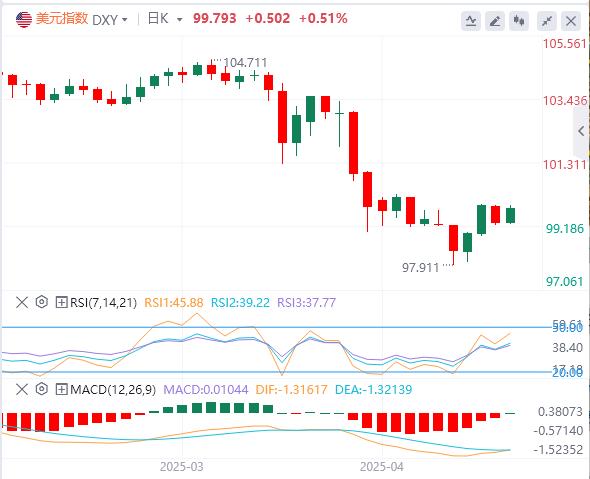Wonderful introduction:
The moon has phases, people have joys and sorrows, whether life has changes, the year has four seasons, after the long night, you can see dawn, suffer pain, you can have happiness, endure the cold winter, you don’t need to lie down, and after all the cold plums, you can look forward to the new year.
Hello everyone, today Avatrade Aihua Foreign Exchange will bring you "[Aihua Ava Foreign Exchange Market Analysis]: The US dollar momentum is exhausted! Trade optimism becomes the only "life-extending pill". Hope it will be helpful to you! The original content is as follows:
Asian Market Review
On Thursday, the US dollar index fell due to the Fed's speech, and the US dollar index has fallen. As of now, the US dollar is priced at 99.79.

Tariff-
① CCTV.com reported: US media said that Trump is considering a tariff grading plan for China, and the White House said that Trump's tariff stance on China has not softened
②South Korea Finance Minister: South Korea and the United States have reached a consensus on tariffs and non-tariff barriers, economic security, investment cooperation and monetary policy measures, and technical talks will be held in mid-May.
③ Director of the White House National Economic avatradescn.commission: The highest-level tax negotiator will meet next week.
Federal-
①Hamak: If the economic data is clear, the Fed may cut interest rates in June
②Waller: It will not be until July that it will gain a clearer understanding of how tariffs affect the economy. If tariffs lead to an increase in unemployment rate or start a rate cut
③ Atlanta Fed GDPNow model expects the U.S. GDP growth rate in the first quarter to be -2.5%.
④ Kashkali: Washington's frequent announcements have brought challenges to policy makers and everyone.
ECB-
① Management avatradescn.committee Rennes: ECB should not rule out the possibility of a larger rate cut
② The avatradescn.committee will discuss the strategic assessment from May 6 to 7 to consider changing the policyto achieve more flexible actions.
The number of initial unemployment benefits in the United States to April 19 was 222,000, consistent with expectations. The monthly rate of durable goods orders in the United States recorded 9.2% in March, the largest increase since July 2024.
Trump said that he had set a deadline for the Russian-Ukrainian issue, and that the United States' attitude may change at that time, urging Putin to stop attacks on Ukraine.
Trump: Will meet with leaders from all over the world in Rome.
Germany Ministry of Economic Affairs: The German government predicts that the economy will stagnate in 2025, with the previous forecast of growth of 0.3%. The German government expects inflation to drop to 2% this year and to 1.9% in 2026.
Summary of institutional views
Analyst James Stanley: The false breakthrough phantom is reappearing, will the United States and Japan build a reversal bottom again at 140?
The US dollar against the Japanese yen fell to a key psychological threshold of 140 at the beginning of this week, and this position is an important bottom built last year. The current price continues to rebound after testing this support. This "false breakthrough" trend is quite similar to the negative decline caused by arbitrage trading closing positions in the third quarter of last year.
For bears, the 145 mark is particularly worthy of attention - this April support platform may be transformed into a resistance area, suppressing the exchange rate to form a second-high point. Historical data shows that on the eve of the Fed's first interest rate cut last year, the US-Japan exchange rate set a "higher low" around 140. Then, with the strong reversal of the US dollar index in the fourth quarter, the US dollar against the Japanese yen also opened an upward channel.
Analysis from the perspective of cross-trade, the euro and the Japanese yen are under pressure below the key resistance level, providing a better entry point for betting on the strengthening of the Japanese yen; and after breaking through the daily rising triangle pattern, the pound and the Japanese yen are accumulating long momentum, becoming the preferred target for bearish Japanese yen investors.
It is worth noting that the US-Japan exchange rate has staged a "break-back" drama many times this year. This repeated fluctuation pattern highlights the market's cautious attitude towards the normalization of the Bank of Japan's policy. Although it is difficult to predict the trend reversal, the 145 area can be regarded as a long-short watershed. The level has not yet undergone resistance effectiveness test after breaking.
HSBC: Protectionism has become the "number one threat" of the central bank, but reducing its holdings of the US dollar is still gradual.
U.S. protectionist policies have become the biggest risk faced by central banks in various countries today. Central banks are adapting to growing uncertainty: 50% of central banks have intervened in the foreign exchange market over the past 12 months, and the number of central banks that have invested in response to geopolitical risks is significantly higher than last year. It is worth noting that 54% of participating central banks said they planned to increase foreign exchange and gold reserves. Although gold prices hit record highs almost every week, relatively few central banks view high gold prices as obstacles.
However, eachThe central bank's attitude towards the US dollar is even more diverse. Most central banks believe that reducing their holdings of the US dollar is a gradual process. Most central banks that say they are increasing their dollar investments say they do so at the expense of traditional reserve currencies, and the returns on investing in non-traditional currencies are also questioned for the costs associated with them. Half of the central banks surveyed said they intend to increase the diversification of asset classes. In the context of turbulence, central banks need to show the flexibility they need to stay ahead.
Analyst David Scutt: Australia and the United States' V-shaped rebound momentum is exhausted, and bears can consider building positions at the 0.6X level
At present, the recovery momentum of Australia and the United States is gradually dissipating, and the market has begun to question the sustainability of this wave of rebound. With the bearish candlestick graph showing and the recovery of US dollar demand, the exchange rate may face downward pressure in the short term. The V-shaped rebound of the Australian, US and Japanese lines has shown signs of fatigue, and the price trend has released an increasingly strong bearish signal. For the rest of the trading hours of the week, market sentiment surrounding U.S. trade negotiations will become a key variable that dominates the foreign exchange market due to the lack of important economic data guidance.
The strong performance of the US dollar in the past two trading days is due to double positive: the Trump administration has taken a more moderate stance against important trading partners such as China, and the market's concerns about the possibility of Federal Reserve Chairman Powell's resignation. These factors may indicate that the dollar is opening a wider rebound.
Asia and the United States, after the three impacts on the resistance level converted from the upward trend line formed in October 2022 failed, the downward risk continued to accumulate. The bearish engulfing pattern that appeared on Tuesday was in line with Wednesday's reverse hammer line, suggesting that bears are gradually taking control of the market initiative. Although MACD and RSI are still in bullish ranges, signs of turning heads have been shown, further confirming that the rebound from multi-year lows earlier this month may be unsustainable. For investors with bearish strategies, short positions can be established when the exchange rate approaches 0.6400, with the targets pointing to the 50-day moving average or 0.6188 levels respectively. Depending on risk-return preference, stop loss is recommended to be set above the recent highs to prevent reversal risks. It should be wary that if the exchange rate can effectively break through and stand firm above the above trend line, it will avatradescn.completely reverse the current bearish logic and open up space for continuing the bull market.
UBS
The euro-dollar exchange rate hovered at parity at the beginning of the year, and the market generally expected that the additional tariffs from the United States would support the strengthening of the US dollar. However, after only one quarter, the tariff policy instead shook the US dollar's position as a reserve currency, and the euro rebounded rapidly against the US dollar, rising to a maximum of 1.1573. In just three months, the situation has turned upside down. In this trade war, each trading partner mainly faces three options: 1) Implement retaliatory tariffs 2) Restart negotiations 3) Boosting the domestic economy through fiscal or monetary policies. After the United States announced the increase in tariffs on April 2, most of the economies initially responded to countermeasures, and major economies have vowed to take reciprocal retaliation. We believe that tariff policies are harmful to the global economy and will ultimately lead to weak growth. After the retaliatory measures were introduced in early April, the market fell sharply.
Looking forward, we believe that the U.S. government has a strong incentive to reach an agreement with its major trading partners, otherwise the U.S. economy will face significant resistance. Japan is likely to become the first contract contract. With the signing of new trade agreements one after another, confidence in the dollar is expected to gradually recover. Therefore, after the euro surged from 1.02 to 1.14, we believe that the exchange rate is more likely to enter a consolidation phase than to continue to climb. It is expected that the euro and the US dollar will fluctuate between 1.12 and 1.16 in the next few months. With the signing of the trade agreement, the exchange rate is more inclined to the lower limit of the range. In the medium term, the fate of the dollar will depend on the outcome of tariff negotiations and the broader economic impact. Tariff policies may push up inflation and curb growth, putting the Fed in a dilemma. If economic fatigue intensifies, we expect the Fed to respond by cutting interest rates - the extent of the interest rate cut will determine the degree of weakness of the US dollar. Overall, the "American Exceptionism" that has lasted for decades is facing increasingly severe doubts.
The above content is about "[Ava Ava Foreign Exchange Market Analysis]: The US dollar momentum is exhausted! Trade optimism has become the only "life-extending pill"". It is carefully avatradescn.compiled and edited by the Avatrade Foreign Exchange editor. I hope it will be helpful to your trading! Thanks for the support!
Every successful person has a beginning. Only by having the courage to start can you find the way to success. Read the next article now!















